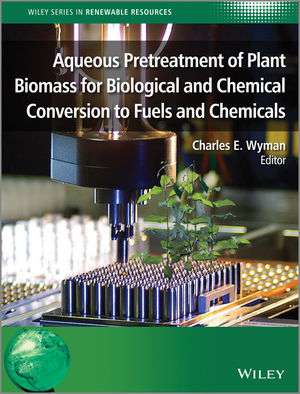Turning plant matter into fuel: Book by UC Riverside professor focuses on aqueous processing of cellulosic biomass

A University of California, Riverside professor in the Chemical and Environmental Engineering Department edited a recently published book that provides in-depth information on aqueous processing of cellulosic biomass, which includes wood, grasses, and agricultural and forestry residues, for conversion into fuels.
Charles Wyman, who also holds the Ford Motor Company Chair in Environmental Engineering in the Center for Environmental Research and Technology (CE-CERT) of the UC Riverside Bourns College of Engineering, led the development of the book "Aqueous Pretreatment of Plant Biomass for Biological and Chemical Conversion to Fuels and Chemicals." The book, published by John Wiley & Sons, contains 23 chapters written by experts from throughout the country.
Charles Wyman's passion for renewable energy was first expressed through a junior high school science fair project focused on solar energy storage. It grew as he earned a Ph.D. in chemical engineering at Princeton, became a leader in biomass conversion at the Solar Energy Research Institute, now known as the National Renewable Energy Laboratory, and as an endowed professor at Dartmouth College.
In 1996, during his tenure at National Renewable Energy Laboratory, he edited the book Handbook on Bioethanol: Production and Utilization. He also co-founded Mascoma Corporation, a startup company focused on advanced technology for biomass conversion to ethanol, in 2005.
The just-published book focuses on aqueous pretreatment of cellulosic biomass to promote sugar release for biological, catalytic, or thermochemical conversion into fuels and chemicals.
Introductory chapters provide the rationale for converting biomass to fuels; its importance to national security, balance of trade, and the environment; and insights into biological and catalytic processing to fuels. Also included are in-depth information on the chemistry and biology of cellulosic biomass, leading pretreatments to facilitate its biological and chemical conversion to sugars, and methods important to assess the effectiveness of biomass conversion technologies.
In recent decades, interest in converting cellulosic biomass to fuels has closely tracked the price of petroleum: support jumps when petroleum prices are high and wanes when prices drop.
"That creates a big challenge," Wyman said. "The volatility of oil prices and associated enthusiasm for alternatives results in a very unstable environment in which to build a business."
Yet, cellulosic biomass conversion has unique and powerful benefits.
It has the potential to substantially reduce greenhouse gas emissions and imported petroleum dependence and is widely available and inexpensive. For example, cellulosic biomass costing $60 per dry ton has about the same cost per energy content as petroleum at about $20 per barrel.
"The challenge is, and has always been, reducing the cost of breaking down cellulosic biomass into sugars and other fuel precursors that can be converted into products, and aqueous pretreatment plays a pivotal role for leading biological, catalytic, and thermochemical routes" Wyman said.
Provided by University of California - Riverside



















